Australia—Exporters face rising costs and ongoing supply disruptions
Latest data from the Australian Bureau of Statistics (ABS) shows the number of exporters increased marginally to 56,274 in 2019-20 and merchandise exports reached record high levels. The mining industry drove the increase in the number of exporters—of which they are predominantly large exporters—having benefited from rising commodity prices and recovering global demand in the past two years.
But 62% of all Australian exporters are small. They have less scope to raise prices on global markets and are more likely to be vulnerable to higher cost pressures from rising wages, increasing interest rates and supply disruptions than large exporters. Reflecting this, ABS data indicate 57% of businesses experienced increased costs over the three months to April—particularly the cost of fuel and energy and other operating expenses—of which less than half (48%) have completely or partially passed on increased costs to customers (Chart).
Businesses also face ongoing staff shortages and supply disruptions that will likely add to cost pressures and hit revenue. In April, 18% of Australian businesses did not have enough employees, of which 84% of these businesses faced difficulties finding suitable staff. However, the impact of COVID-19 on staff levels appears to be easing; with 36% of businesses feeling some effects in April compared to 62% in January. More than two-in-five businesses (41%) experienced supply chain disruptions in April 2022, up from 30% in April 2021. Of these businesses, almost one-third reported major supply delays for certain items and significant impact on revenue, and 67% reported some delays but little impact on revenue. In response to rising costs, some businesses are changing their operations and processes, cutting back on investment, seeking additional finance or renegotiating payment terms with customers and suppliers.


